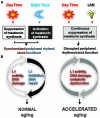The aging clock and circadian control of metabolism and genome stability
- PMID: 25642238
- PMCID: PMC4294216
- DOI: 10.3389/fgene.2014.00455
The aging clock and circadian control of metabolism and genome stability
Abstract
It is widely accepted that aging is characterized by a gradual decline in the efficiency and accuracy of biological processes, leading to deterioration of physiological functions and development of age-associated diseases. Age-dependent accumulation of genomic instability and development of metabolic syndrome are well-recognized components of the aging phenotype, both of which have been extensively studied. Existing findings strongly support the view that the integrity of the cellular genome and metabolic function can be influenced by light at night (LAN) and associated suppression of circadian melatonin production. While LAN is reported to accelerate aging by promoting age-associated carcinogenesis in several animal models, the specific molecular mechanism(s) of its action are not fully understood. Here, we review literature supporting a connection between LAN-induced central circadian disruption of peripheral circadian rhythms and clock function, LINE-1 retrotransposon-associated genomic instability, metabolic deregulation, and aging. We propose that aging is a progressive decline in the stability, continuity, and synchronization of multi-frequency oscillations in biological processes to a temporally disorganized state. By extension, healthy aging is the ability to maintain the most consistent, stable, and entrainable rhythmicity and coordination of these oscillations, at the molecular, cellular, and systemic levels.
Keywords: LINE-1; aging; light exposure at night; metabolism; retroelements.
Figures


Similar articles
-
LINE-1 activity as molecular basis for genomic instability associated with light exposure at night.Mob Genet Elements. 2015 Apr 7;5(3):1-5. doi: 10.1080/2159256X.2015.1037416. eCollection 2015 May-Jun. Mob Genet Elements. 2015. PMID: 26442182 Free PMC article.
-
Circadian regulation of cell cycle: Molecular connections between aging and the circadian clock.Ann Med. 2010 Sep;42(6):404-15. doi: 10.3109/07853890.2010.499134. Ann Med. 2010. PMID: 20568980 Review.
-
Aging with rhythmicity. Is it possible? Physical exercise as a pacemaker.Life Sci. 2020 Nov 15;261:118453. doi: 10.1016/j.lfs.2020.118453. Epub 2020 Sep 18. Life Sci. 2020. PMID: 32956663 Free PMC article. Review.
-
Daily NO rhythms in peripheral clocks in aging male Wistar rats: protective effects of exogenous melatonin.Biogerontology. 2016 Nov;17(5-6):859-871. doi: 10.1007/s10522-016-9656-6. Epub 2016 Sep 10. Biogerontology. 2016. PMID: 27614960
-
Amyloid-β-Induced Changes in Molecular Clock Properties and Cellular Bioenergetics.Front Neurosci. 2017 Mar 17;11:124. doi: 10.3389/fnins.2017.00124. eCollection 2017. Front Neurosci. 2017. PMID: 28367108 Free PMC article.
Cited by
-
How does healthy aging impact on the circadian clock?J Neural Transm (Vienna). 2017 Feb;124(Suppl 1):89-97. doi: 10.1007/s00702-015-1424-2. Epub 2015 Jul 15. J Neural Transm (Vienna). 2017. PMID: 26175004 Review.
-
Treadmill Training Effect on the Myokines Content in Skeletal Muscles of Mice With a Metabolic Disorder Model.Front Physiol. 2021 Nov 10;12:709039. doi: 10.3389/fphys.2021.709039. eCollection 2021. Front Physiol. 2021. PMID: 34858197 Free PMC article.
-
Working against the biological clock: a review for the Occupational Physician.Ind Health. 2019 Sep 26;57(5):557-569. doi: 10.2486/indhealth.2018-0173. Epub 2019 Feb 22. Ind Health. 2019. PMID: 30799323 Free PMC article. Review.
-
Disruption of circadian rhythm as a potential pathogenesis of nocturia.Nat Rev Urol. 2025 May;22(5):276-293. doi: 10.1038/s41585-024-00961-0. Epub 2024 Nov 14. Nat Rev Urol. 2025. PMID: 39543359 Free PMC article. Review.
-
Restricting retrotransposons: a review.Mob DNA. 2016 Aug 11;7:16. doi: 10.1186/s13100-016-0070-z. eCollection 2016. Mob DNA. 2016. PMID: 27525044 Free PMC article. Review.
References
Publication types
Grants and funding
LinkOut - more resources
Full Text Sources
Other Literature Sources

